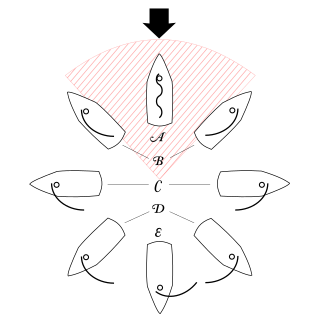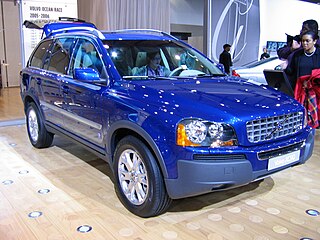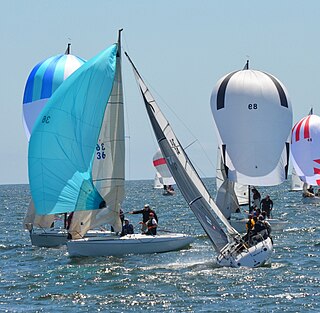
Sailing employs the wind—acting on sails, wingsails or kites—to propel a craft on the surface of the water, on ice (iceboat) or on land over a chosen course, which is often part of a larger plan of navigation.

A sailboat or sailing boat is a boat propelled partly or entirely by sails and is smaller than a sailing ship. Distinctions in what constitutes a sailing boat and ship vary by region and maritime culture.

The keel is the bottom-most longitudinal structural element on a vessel. On some sailboats, it may have a hydrodynamic and counterbalancing purpose, as well. As the laying down of the keel is the initial step in the construction of a ship, in British and American shipbuilding traditions the construction is dated from this event.

A point of sail is a sailing craft's direction of travel under sail in relation to the true wind direction over the surface.

A centreboard or centerboard (US) is a retractable keel which pivots out of a slot in the hull of a sailboat, known as a centreboard trunk (UK) or centerboard case (US). The retractability allows the centreboard to be raised to operate in shallow waters, to move the centre of lateral resistance, to reduce drag when the full area of the centreboard is not needed, or when removing the boat from the water, as when trailering. A centreboard which consists of solely a pivoting metal plate is called a centerplate. A daggerboard is similar but slides vertically rather than pivoting.

Proas are various types of multi-hull outrigger sailboats of the Austronesian peoples. The terms were used for native Austronesian ships in European records during the Colonial era indiscriminately, and thus can confusingly refer to the double-ended single-outrigger boats of Oceania, the double-outrigger boats of Island Southeast Asia, and sometimes ships with no outriggers or sails at all.
A bilgeboard is a lifting foil used in a sailboat, which resembles a cross between a centerboard and a leeboard. Bilgeboards are mounted between the centerline of the boat and the sides, and are almost always asymmetric foils mounted at an angle to maximize lateral lift while minimizing drag. They are most often found on racing scows.
Ballast is used in ships to provide moment to resist the lateral forces on the hull. Insufficiently ballasted boats tend to tip or heel excessively in high winds. Too much heel may result in the vessel capsizing. If a sailing vessel needs to voyage without cargo, then ballast of little or no value will be loaded to keep the vessel upright. Some or all of this ballast will then be discarded when cargo is loaded.

The winged keel is a sailboat keel layout first fitted on the 12-metre class yacht Australia II, 1983 America's Cup winner.

A bulb keel is a keel, usually made with a high aspect ratio foil, that contains a ballast-filled bulb at the bottom, usually teardrop shaped. The purpose of the bulb keel is to place the ballast as low as possible, therefore gaining the maximum possible amount of leverage and thus the most righting moment. An example of a class of boats that use a bulb keel is the International 110 racing class, which uses a 300 lb (136 kg) cast iron bulb keel on a boat whose minimum racing weight is 910 lb (414 kg).
The International Offshore Rule (IOR) was a measurement rule for racing sailboats. The IOR evolved from the Cruising Club of America (CCA) rule for racer/cruisers and the Royal Ocean Racing Club (RORC) rule.

The Volvo Open 70 is the former class of racing yachts designed for the Volvo Ocean Race. It was first used in the 2005–06 race.

A sailing hydrofoil, hydrofoil sailboat, or hydrosail is a sailboat with wing-like foils mounted under the hull. As the craft increases its speed the hydrofoils lift the hull up and out of the water, greatly reducing wetted area, resulting in decreased drag and increased speed. A sailing hydrofoil can achieve speeds exceeding double and in some cases triple the wind speed.

A sailing yacht, is a leisure craft that uses sails as its primary means of propulsion. A yacht may be a sail or power vessel used for pleasure, cruising, or racing. There is no standard definition, so the term applies here to sailing vessels that have a cabin with amenities that accommodate overnight use. To be termed a "yacht", as opposed to a "boat", such a vessel is likely to be at least 33 feet (10 m) in length and have been judged to have good aesthetic qualities. Sailboats that do not accommodate overnight use or are smaller than 30 feet (9.1 m) are not universally called yachts. Sailing yachts in excess of 130 feet (40 m) are generally considered to be superyachts.

The 2005–06 Volvo Ocean Race was held between 5 November 2005 and 17 June 2006. Seven boats took part in the race and made ten stops in nine countries.

Wild Oats XI is a maxi yacht, most famous for being the former race record holder and a nine-times line honours winner of the Sydney to Hobart Yacht Race. Launched in 2005, she was owned by Bob Oatley and skippered by New South Wales Mark Richards, who founded Palm Beach Yachts Australia.

Forces on sails result from movement of air that interacts with sails and gives them motive power for sailing craft, including sailing ships, sailboats, windsurfers, ice boats, and sail-powered land vehicles. Similar principles in a rotating frame of reference apply to wind mill sails and wind turbine blades, which are also wind-driven. They are differentiated from forces on wings, and propeller blades, the actions of which are not adjusted to the wind. Kites also power certain sailing craft, but do not employ a mast to support the airfoil and are beyond the scope of this article.

The Ultimate 20 is a trailerable sailboat that was designed by Jim Antrim as a sportsboat first built by Ultimate Sailboats in 1995. It is a one-design racing keelboat recognized by the International Sailing Federation.
ICAP Leopard 3 is a 30-metre IRC maxi yacht owned and skippered by Helical Bar plc CEO Michael Slade, who has owned maxi yachts for over 22 years. She features a canting keel, water ballast and twin daggerboards amidships.

The Schock 23 is an American trailerable sailboat, that was designed by Steven Schock, with a wing keel designed by Finnish engineer Reijo Salminen and first built in 1999.

















